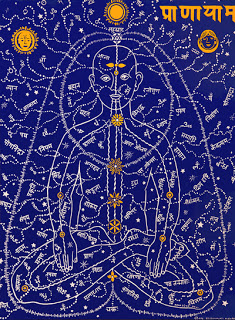Prana Ayama- is the fourth limb of Yoga. It is a way to use the breath to enhance and strengthen ones prana, or "life force". This type of Yoga Breathing is one of the complementary practices involved in practicing Yoga it increases vitality of the practitioner and is a simple exercise that almost anyone can do.
The exercises are a form of purification of the body and mind.
In Light on Pranayama by B.K.S.Iyengar it is described as bringing the practitioner "stability, concentration and mental poise."
It can be a very simple technique for students or a very advanced exercise for the advanced student and can be used throughout ones life at all stages to be a healthy practice.
As one of the main disciplines in traditional Yoga there are many ways to experience the conscious effort to breath known as Pranayama. Here is a basic exercise to draw the mind towards the breath. By observing the complete sustained inhalation and exhalation of the breath completely, without judgment to any limitations or goals the practitioner will benefit from a regular breathing practice.
Prana-yama is best in a seated position or can be very effective laying down. This can be difficult for some people and all people should work with a certified professional to see which position works best.
Prana-yama is best in a seated position or can be very effective laying down. This can be difficult for some people and all people should work with a certified professional to see which position works best.
This allows the body to recharge itself and maintain
regular function of the muscles, nerves, circulation and
emotions.
A healthy breathing regiment will allow the body to be in
Everyone can benefit from Prana-ayama, by
practicing a healthy and happy breathing weekly, or daily
regiment depending on your interest you can stop and
observe the breath one to two times daily.
Depending of your interest and ability one can decide
to increase the observation each time, weekly or when you
feel that the body is ready. Remember no one knows your
body at well as you do!
- Start by coming to a comfortable seated
position, cross legged in easy pose or sitting in a chair.
- Consciously observe the breathing for
one minute. Then relaxing and noticing any
areas of tension.
- Readjusting the posture, realigning the seat &
torso comfortably and gently.
And begin again.
Breathing is important because:
-It is the means the body receives
the essential nutrient Oxygen.
- It is an important way the body
gets rid of waist products and toxins.
Oxygen is important because:
- It is the most vital nutrient in our bodies; it circulates
the blood stream and cleanses the body.
- It is the essential nutrient for proper brain, nerve,
gland and other organs to function.
Without the proper function of the breath the
body becomes week, it experiences reduced vitality,
concentration, and increased susceptibility of disease.
This woman is sitting with her hands gently resting on her hips.
Practice:
Try practicing Prana-yama in this position or one given by your instructor in
class.






